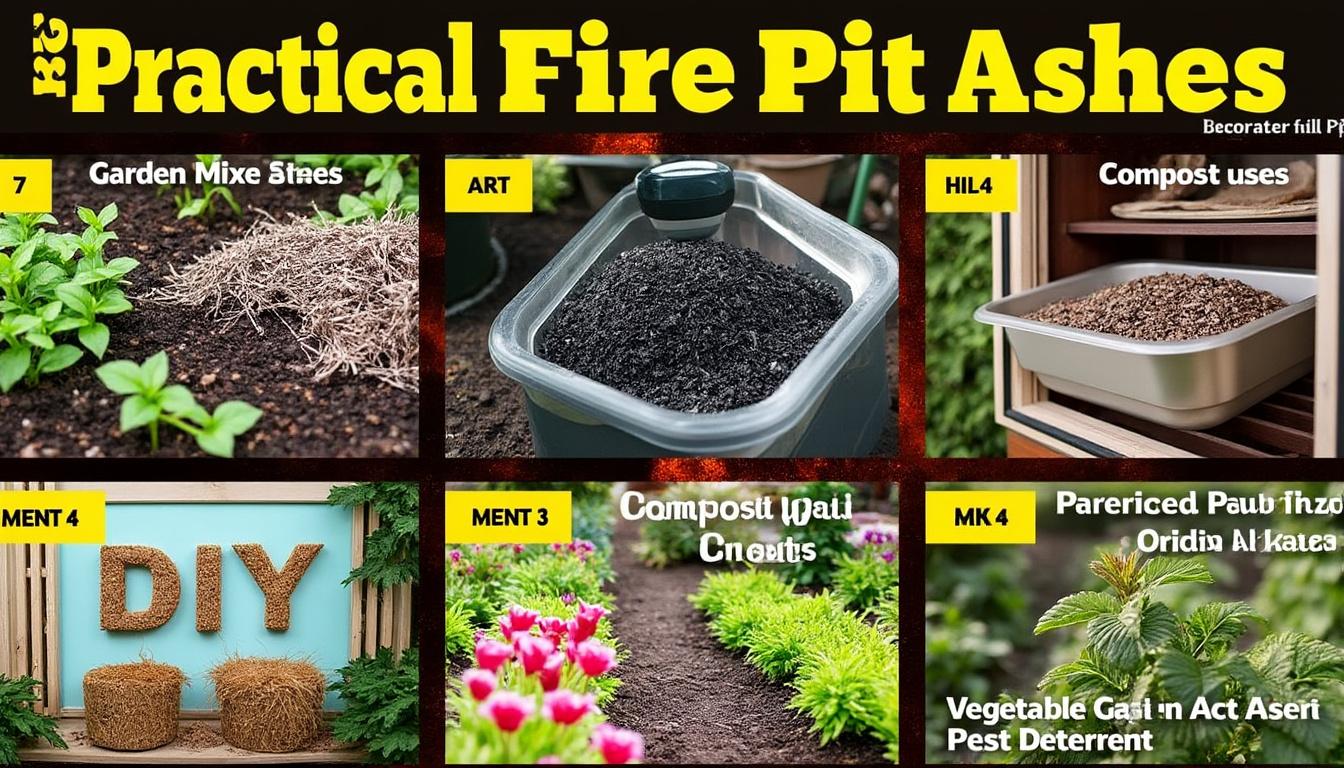Fire pit ashes are often seen as mere waste after a cozy evening around the flames, but discarding them carelessly overlooks their hidden potential. These residues, rich in vital minerals, can be harnessed to transform both your home environment and garden into a more sustainable and resourceful space. With attention to proper handling, ashes become practical tools that extend beyond simple disposal, offering benefits from natural fertilization to effective household uses. As businesses like Gardener’s Supply Company and Miracle-Gro emphasize eco-friendly gardening techniques, incorporating fire pit ashes presents a cost-effective way to support plant health and maintain cleanliness in your surroundings. This article explores six inventive and practical applications of fire pit ashes, revealing how this residue can be an asset rather than a nuisance.
Enhancing Garden Soil Quality With Fire Pit Ashes
One of the most valuable uses for fire pit ashes lies in improving soil health and fertility. Rich in essential elements such as potassium, calcium, and magnesium, ashes function as a natural soil amendment, positively impacting your garden’s growth conditions. The alkalinity of wood ash serves to gently raise the pH of acidic soils, a common issue in many garden environments. This adjustment creates a more balanced environment favorable for a wide range of plants.
Understanding Soil pH Adjustment and Nutrient Enrichment
Testing your garden soil’s pH is a critical first step before applying ashes. Soils with a pH below 6.0 typically benefit from the alkaline nature of ashes, helping boost nutrient availability for plants like tomatoes and peppers, which thrive in neutral to slightly acidic soils. Ash application improves the soil’s cation exchange capacity allowing better retention and availability of nutrients such as nitrogen and phosphorus from fertilizers like those provided by Miracle-Gro or Bonide.
However, caution is essential. Excessive ash application can raise soil pH too high, potentially harming acid-loving plants like azaleas or blueberries. It’s recommended to:
- Apply ashes sparingly, not exceeding 20 pounds per 1000 square feet annually
- Mix ashes evenly into the topsoil to avoid concentrated spots
- Repeat pH testing periodically for optimal soil balance
Consulting suppliers such as Gardener’s Supply Company or The Home Depot for pH testing kits and soil amendments ensures precision in garden care. Integrating ashes can reduce dependence on synthetic lime products, making it an economical and eco-friendly choice.
Case Study: Revitalizing Vegetable Beds With Wood Ash
A local community garden collaborated with EarthEasy, relying on wood ashes sourced from recent fire pits to revitalize nutrient-depleted vegetable beds. Over a growing season, the potassium content supplied by ashes correlated with healthier foliage and increased fruit yields. This example underscores the practical benefits of repurposing fire pit ashes instead of sending them to waste.
| Soil Component | Effect of Adding Fire Pit Ash | Recommended Application |
|---|---|---|
| pH Level | Increases toward neutral (6-7) | Test soil; apply sparingly to acidic soils |
| Potassium | Enhances nutrient availability | Mix thoroughly in vegetable beds |
| Calcium | Improves soil structure and nutrient uptake | Combine with organic compost |
Natural Pest Control and Slug Deterrent Applications Using Ashes
Fire pit ashes are not only beneficial for soil but also serve as an effective natural deterrent against common garden pests such as slugs and snails. Their fine, abrasive texture and alkaline composition create a hostile environment for soft-bodied insects, reducing damage organically without resorting to chemical pesticides.
Implementing Ash Barriers to Protect Plants
Gardeners from Bonsai Outlet and companies specializing in natural gardening supplies advocate for creating ash barriers around vulnerable plants. By sprinkling a thin layer of dry ash around the base of plants, slugs and snails avoid crossing due to the discomfort it causes to their bodies.
For best results, keep in mind:
- Use only dry, cooled ashes to avoid triggering chemical burns on plants
- Reapply after rainfall, as water can dissolve ash barriers
- Combine with companion planting strategies to boost pest resistance
Such approaches align with sustainable gardening practices, minimizing the use of synthetic pesticides from brands like Bonide, fostering healthier ecosystems.
Examples of Pest Management Successes
Several gardeners have reported significant reductions in slug activity after incorporating ash barriers in their raised beds and decorative flower gardens. In urban settings, Black+Decker tool users have effectively maintained tidy ash lines using blower attachments for precise application, demonstrating innovative low-cost pest control solutions.
| Pest | Effectiveness of Ash Barrier | Notes for Application |
|---|---|---|
| Slugs | Highly effective | Keep ash dry; reapply after rain |
| Snails | Moderately effective | Best combined with physical barriers |
| Ants | Limited effect | Use other control methods as well |
Eco-Friendly Ice Melt and Traction Aids for Winter Using Fire Pit Ashes
During winter months, fire pit ashes can serve as a sustainable alternative to commercial ice melts and grit products, commonly stocked by outlets like Menards and The Home Depot. Unlike chemical-based ice melts, ashes reduce environmental contamination while providing effective traction on icy surfaces.
How Ashes Work as Ice Melt and Traction Aids
The dark color of ashes absorbs sunlight, encouraging faster melting of ice patches. Their granular texture enhances grip on slippery walkways, driveways, and stairs without corroding concrete or metal like many salt-based products do. This makes ashes an excellent eco-conscious choice for homeowners wary of long-term surface damage.
To maximize usefulness:
- Ensure ashes are fully cooled and dry to prevent freezing into ice lumps
- Apply a moderate layer over icy patches before and during cold spells
- Combine with sand or small gravel for increased traction if necessary
DIY enthusiasts equipped with Black+Decker tools can utilize their outdoor sweepers and blowers to distribute ashes evenly over larger areas, optimizing coverage and reducing manual labor.
| Winter Use | Advantages | Precautions |
|---|---|---|
| Ice Melting | No toxic chemicals; absorbs heat | Apply to dry surfaces only |
| Traction Aid | Enhanced grip on slippery surfaces | May stain light-colored surfaces |
| Environmental Impact | Biodegradable and non-corrosive | Use away from water runoff areas |
This video demonstrates practical tips for using fire pit ashes safely and effectively as a winter traction aid, including coverage techniques and safety precautions.
Household Cleaning and Odor Absorption Benefits From Fire Pit Ashes
Beyond outdoor applications, fire pit ashes offer valuable uses inside the home. Historically, ashes were employed as a mild abrasive cleaner and deodorizer, capable of enhancing home hygiene when used correctly. As brands like Scotch Blue and Black+Decker innovate household maintenance products, ashes continue to be a natural complement or alternative.
Cleaning Applications of Wood Ash
Wood ashes possess gentle abrasive properties due to their fine particulate matter and alkaline nature. Mixing ashes with water forms a soft paste that can clean tarnished metals, glass ovens, and sooty surfaces without harsh chemicals. However, caution is warranted as excessive scrubbing or coarse ash particles may scratch delicate materials.
- Use ash paste to clean fireplace glass or BBQ grills (like those from Weber)
- Apply on tarnished silverware with soft cloths
- Test on small areas before full application to avoid damage
Utilizing Ash for Odor Control
Ashes also neutralize unpleasant odors effectively due to their alkaline pH, absorbing smells from refrigerators, garbage cans, and even pet areas. Sprinkling a thin layer of ash in these zones helps maintain freshness naturally without synthetic deodorizers.
| Use Case | Description | Application Tips |
|---|---|---|
| Metal Cleaning | Remove tarnish and soot gently | Use ash paste with soft cloths |
| Odor Absorption | Neutralizes odors naturally | Place in open containers in affected areas |
| General Abrasive Cleaning | Scrubs surfaces like grout and tiles | Test small spots first; avoid delicate surfaces |
This tutorial explores safe and effective household cleaning methods using wood ashes, highlighting the importance of testing and proper application.
Fire Pit Ashes as Compost Booster and Soil Amendment
Composting benefits greatly from the inclusion of fire pit ashes due to their capacity to balance acidic components and introduce minerals that enhance microbial activity. This aligns with organic gardening philosophies endorsed by companies such as EarthEasy and Gardener’s Supply Company, which promote sustainable composting practices.
How Ashes Improve Compost Quality
Adding small quantities of ashes to compost piles helps raise the pH, making the environment less acidic and more suitable for beneficial bacteria and earthworms. This accelerates decomposition and results in nutrient-rich compost suitable for a variety of plants. It also discourages pests that prefer more acidic conditions.
Best practices for using ashes in compost include:
- Mix ashes evenly to avoid localized high pH spots
- Limit amounts to about 5% of total compost volume
- Combine with nitrogen-rich materials to maintain balanced carbon to nitrogen ratio
Success Stories From Home Composters
Home gardeners using compost bins with Ash additions report improved soil tilth and plant vigor. Bonsai Outlet users noted better root development in bonsai species attributed to well-balanced compost that included wood ash. Similarly, those growing vegetables under black plastic mulch from Scotch Blue noticed enhanced soil structure where ash-enriched compost was utilized.
| Compost Component | Role of Fire Pit Ash | Recommended Use |
|---|---|---|
| pH Neutralization | Raises acidity to suitable levels | Mild application, test compost regularly |
| Mineral Enrichment | Supplies potassium, calcium | Combine with green and brown materials |
| Microbial Health | Supports beneficial bacteria growth | Avoid excess ash to maintain moisture |
Frequently Asked Questions About Using Fire Pit Ashes
| Question | Answer |
|---|---|
| Is it safe to use fire pit ashes in my garden? | Yes, when ashes are completely cooled and applied in moderation, they are safe and beneficial for most garden plants. |
| Can fire pit ashes be used indoors? | Yes, ashes can be used as an abrasive cleaner and odor absorber indoors, but only dry ashes should be used carefully on suitable surfaces. |
| How should fire pit ashes be stored before use? | Store ashes in a metal container with a tight lid away from flammable materials to ensure safety and prevent accidental ignition. |
| Do fire pit ashes replace commercial fertilizers? | Ashes supplement soil minerals but do not replace balanced fertilizers like those from Miracle-Gro; they should be part of an integrated garden nutrition plan. |
| Can ashes be harmful to plants? | Excessive use can raise soil pH too much, which may harm acid-loving plants; always perform soil testing before application. |

